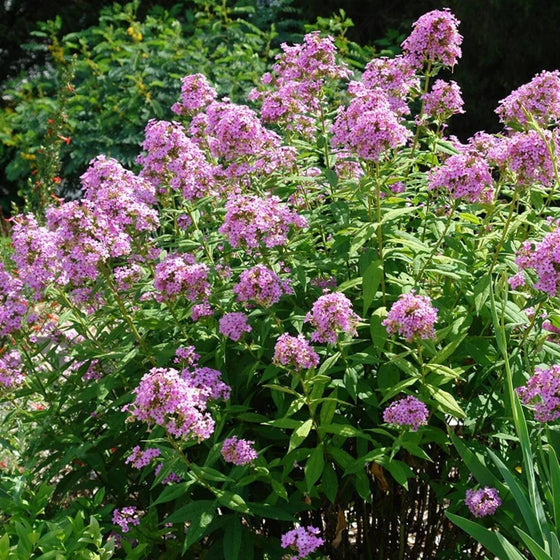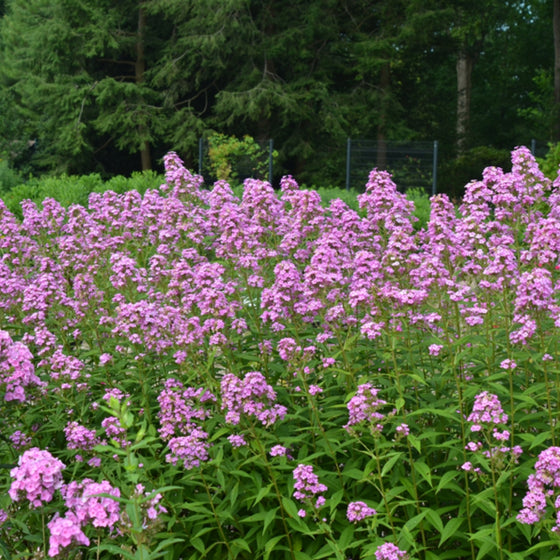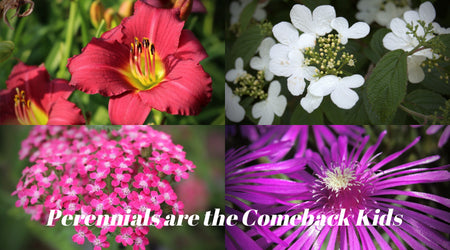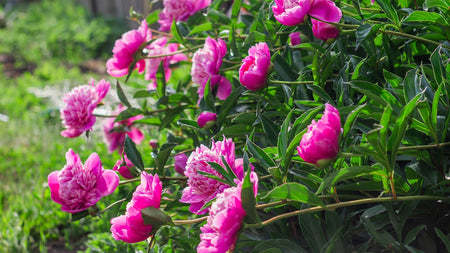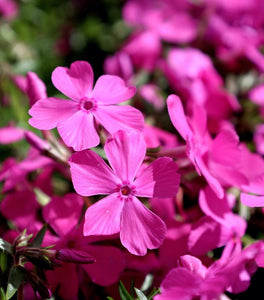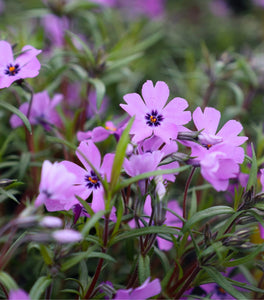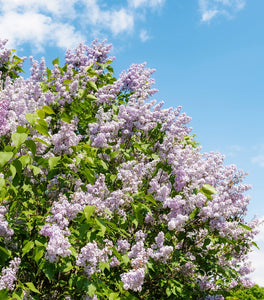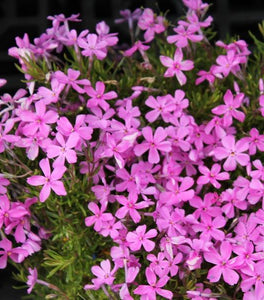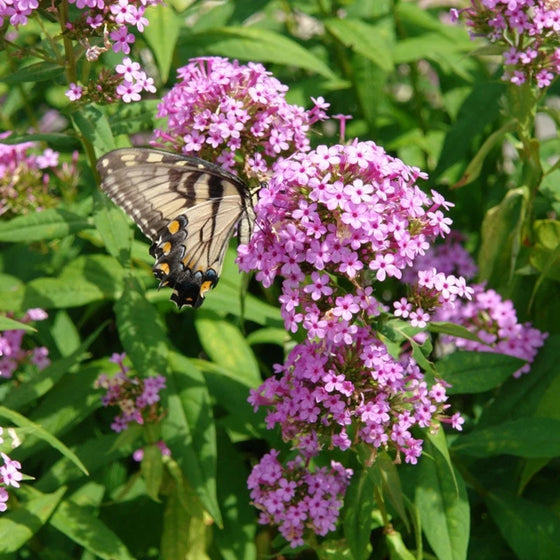
Images Depict Mature Plants
Phlox paniculata Jeana for Sale Online
Phlox paniculata ‘Jeana’ is a standout perennial garden phlox prized for its exceptional mildew resistance, tall upright habit, and pollinator-friendly lavender-pink blooms. Named after the woman who discovered it growing wild in Tennessee, this cultivar produces clusters of small, fragrant flowers that bloom prolifically from mid to late summer. Reaching 4 to 5 feet, ‘Jeana’ makes a dramatic vertical statement in sunny borders, cottage gardens, and native plantings. At the same time, its long-lasting blooms provide consistent color during the height of summer.
One of Phlox ‘Jeana’s most notable virtues is its exceptional resistance to powdery mildew—a common problem with many other tall phlox varieties. This makes it a reliable, low-maintenance choice for gardeners who want classic phlox beauty without the fuss. Its strong stems remain upright without staking, and its narrow, bushy form integrates easily into mixed borders, where it complements ornamental grasses, echinacea, rudbeckia, and other mid-to-late summer bloomers. ‘Jeana’ thrives in full sun and moist, well-drained soil, and it’s hardy in USDA Zones 4–8.
In addition to its landscape appeal, Phlox paniculkata ‘Jeana’ is an outstanding pollinator plant. The dense flower clusters are highly attractive to butterflies—especially swallowtails—and hummingbirds, earning it a top rating in pollinator plant trials. It also draws in bees and other beneficial insects, making it a valuable addition to wildlife-friendly gardens. With its blend of disease resistance, showy blooms, and ecological value, Phlox ‘Jeana’ is an ideal choice for gardeners looking to add beauty and biodiversity to their summer garden.
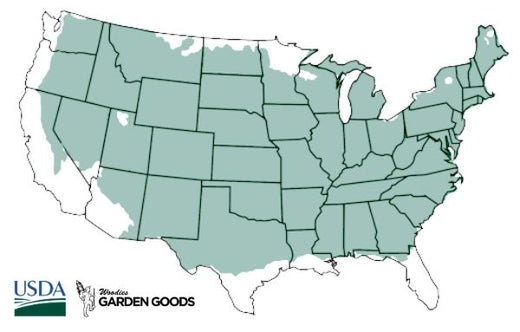
| Hardiness Zone: | 4-8 |
|---|---|
| Mature Height: | 4-5 feet |
| Mature Width: | 1.5-2 feet |
| Classification: | Perennial |
| Sunlight: | Full Sun |
| Habit: | Upright |
| Flower Color: | Lavender Pink |
| Flowering Season: | Late Spring through Mid Summer |
| Foliage: | Green, Needle shape |
| Soil Condition: | Prefers dry, average to sandy soil |
| Water Requirements: | Water well until established |
| Uses: | Mass planting, Ground Cover |
How to Care for Phlox paniculata Jeana
Be sure to read our planting instructions to ensure a healthy and happy Phlox Jeana for years to come!
How do I Plant a Phlox paniculata 'Jeana'?
To plant Phlox paniculata ‘Jeana’, choose a location that receives full sun—at least 6 hours of direct sunlight daily—for the best bloom production and overall vigor. This tall garden phlox thrives in well-drained, fertile soil enriched with compost or organic matter. Begin by digging a hole twice as wide and the same depth as the root ball, then gently loosen the roots and place the plant so that the crown is level with the surrounding soil. Backfill with soil, pressing gently to eliminate air pockets, and water thoroughly to help establish strong roots. Space plants about 18 to 24 inches apart to allow for good air circulation, which helps prevent disease and promotes healthy growth. After planting Phlox ‘Jeana’, apply a 2- to 3-inch layer of mulch around the base, being careful to keep it a few inches away from the stems to prevent rot. Mulching helps retain moisture, suppress weeds, and regulate soil temperature. Water regularly, especially during the first growing season, to keep the soil consistently moist but not soggy. With its upright growth habit and fragrant, pollinator-attracting lavender-pink blooms, Phlox paniculata ‘Jeana’ is a stunning choice for borders, native plant gardens, and butterfly-friendly landscapes. Proper planting sets the foundation for a strong, long-lasting perennial that brings both beauty and biodiversity to your garden.

How do I fertilize a Phlox paniculata 'Jeana'?
To fertilize Phlox paniculata ‘Jeana’, apply a balanced, slow-release fertilizer in early spring as new growth begins to emerge. A fertilizer with an N-P-K ratio such as 10-10-10 or 5-10-5 will provide the right mix of nutrients to support strong root development, lush foliage, and prolific flower production. Spread the fertilizer evenly around the base of the plant, keeping it a few inches away from the stems to avoid burn. Water thoroughly after applying to help the nutrients soak into the soil and reach the root zone. Fertilizing early gives Phlox ‘Jeana’ the boost it needs for a vibrant, full bloom season. For continued performance, you can apply a second light feeding in midsummer, especially if the plant is grown in nutrient-poor soil or has been heavily watered during dry conditions. Alternatively, top-dressing with compost or organic mulch in the spring and again midseason will enrich the soil naturally while also improving moisture retention. Avoid high-nitrogen fertilizers, as they may encourage leafy growth at the expense of flowers. With the right fertilization routine, Phlox paniculata ‘Jeana’ will deliver tall, upright stems covered in fragrant lavender-pink blooms that attract butterflies and pollinators to your summer garden.
How do I water a Phlox paniculata 'Jeana'?
Watering Phlox paniculata ‘Jeana’ properly is essential to support its vigorous growth, vibrant blooms, and mildew resistance. During the first growing season, water deeply once or twice per week to keep the soil evenly moist, especially during dry periods. Use a soaker hose or water at the base of the plant to avoid wetting the foliage, which can help reduce the risk of powdery mildew. Established plants will benefit from consistent moisture, but they do not like soggy soil—so be sure the planting area drains well to prevent root rot and other water-related issues. As a summer-blooming perennial, Phlox ‘Jeana’ appreciates regular watering when temperatures rise and rainfall is scarce. A 2- to 3-inch layer of mulch around the base will help retain moisture and regulate soil temperature, making your watering efforts more effective. Check soil moisture by feeling the top inch; if it feels dry, it’s time to water. Proper watering will keep your Phlox paniculata ‘Jeana’ healthy and vibrant, producing tall, fragrant lavender-pink flower clusters that attract butterflies, hummingbirds, and pollinators throughout the season.

How and when should I Prune a Phlox paniculata 'Jeana'?
Pruning Phlox paniculata 'Jeana' is important for encouraging continuous blooming, maintaining a tidy appearance, and promoting healthy airflow around the plant. The best time to perform major pruning is in late fall after the first hard frost or in early spring before new growth begins. Cut back the entire plant to just a few inches above the ground using clean, sharp pruners. This seasonal pruning removes spent stems and old foliage, helping to prevent overwintering pests and diseases while setting the stage for a vigorous flush of growth in spring. During the growing season, you can also lightly prune or deadhead Phlox 'Jeana' to encourage a longer bloom time and prevent self-seeding. Remove spent flower heads just above the next set of healthy leaves to stimulate new blooms and keep the plant looking fresh. Additionally, thinning a few inner stems in early summer can increase air circulation, which further reduces the risk of powdery mildew—although ‘Jeana’ is already highly mildew-resistant. With proper and timely pruning, this tall garden phlox will deliver a stunning display of fragrant lavender-pink blooms that attract butterflies and pollinators from midsummer through fall.

